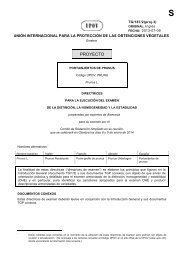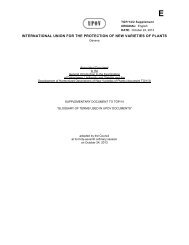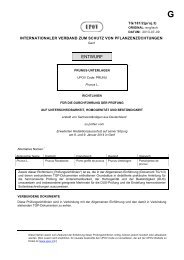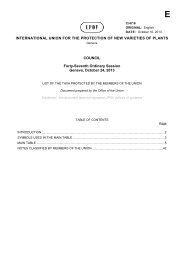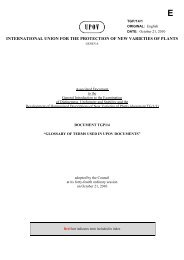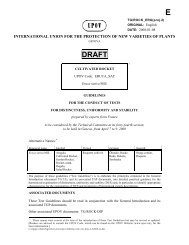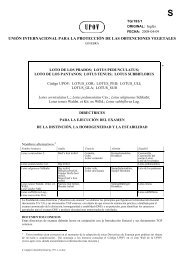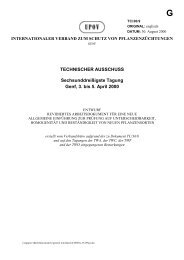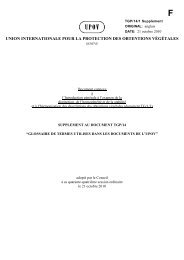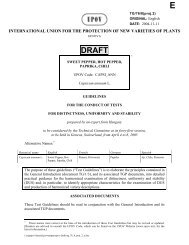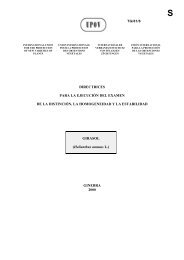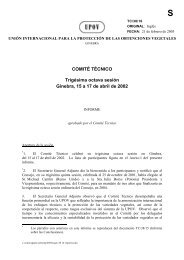(Pleurotus ostreatus (Jacq.) P. Kumm.) - International Union for the ...
(Pleurotus ostreatus (Jacq.) P. Kumm.) - International Union for the ...
(Pleurotus ostreatus (Jacq.) P. Kumm.) - International Union for the ...
You also want an ePaper? Increase the reach of your titles
YUMPU automatically turns print PDFs into web optimized ePapers that Google loves.
E<br />
TG/PLEUR(proj.5)<br />
ORIGINAL: English<br />
DATE: 2013-02-11<br />
INTERNATIONAL UNION FOR THE PROTECTION OF NEW VARIETIES OF PLANTS<br />
Geneva<br />
DRAFT<br />
OYSTER MUSHROOM;<br />
KING OYSTER MUSHROOM;<br />
LUNG OYSTER MUSHROOM<br />
UPOV Code: PLEUR_OST; PLEUR_ERY;<br />
PLEUR_PUL<br />
<strong>Pleurotus</strong> <strong>ostreatus</strong> (<strong>Jacq</strong>.) P. <strong>Kumm</strong>.;<br />
<strong>Pleurotus</strong> eryngii (DC.) Quél.;<br />
<strong>Pleurotus</strong> pulmonarius (Fr.) Quél.<br />
*<br />
Alternative Names: *<br />
GUIDELINES<br />
FOR THE CONDUCT OF TESTS<br />
FOR DISTINCTNESS, UNIFORMITY AND STABILITY<br />
prepared by an expert from <strong>the</strong> Republic of Korea<br />
to be considered by <strong>the</strong><br />
Technical Committee at its <strong>for</strong>ty-ninth session,<br />
to be held in Geneva from March 18 to 20, 2013<br />
Botanical name English French German Spanish<br />
<strong>Pleurotus</strong> <strong>ostreatus</strong><br />
(<strong>Jacq</strong>.) P. <strong>Kumm</strong>.<br />
<strong>Pleurotus</strong> eryngii<br />
(DC.) Quél.<br />
<strong>Pleurotus</strong><br />
pulmonarius<br />
(Fr.) Quél.<br />
Oyster Mushroom Pleurote en coquille Austernseitling,<br />
Drehling<br />
Eringi,<br />
King Oyster Mushroom<br />
Lung Oyster<br />
Mushroom<br />
Kräuterseitling<br />
Girgola,<br />
Seta de ostra,<br />
Champiñon ostra<br />
Seta de cardo<br />
Pleuroto pulmonado,<br />
Pleuroto de verano<br />
The purpose of <strong>the</strong>se guidelines (“Test Guidelines”) is to elaborate <strong>the</strong> principles contained in <strong>the</strong> General<br />
Introduction (document TG/1/3), and its associated TGP documents, into detailed practical guidance <strong>for</strong> <strong>the</strong><br />
harmonized examination of distinctness, uni<strong>for</strong>mity and stability (DUS) and, in particular, to identify<br />
appropriate characteristics <strong>for</strong> <strong>the</strong> examination of DUS and production of harmonized variety descriptions.<br />
ASSOCIATED DOCUMENTS<br />
These Test Guidelines should be read in conjunction with <strong>the</strong> General Introduction and its associated TGP<br />
documents.<br />
*<br />
These names were correct at <strong>the</strong> time of <strong>the</strong> introduction of <strong>the</strong>se Test Guidelines but may be revised or updated. [Readers<br />
are advised to consult <strong>the</strong> UPOV Code, which can be found on <strong>the</strong> UPOV Website (www.upov.int), <strong>for</strong> <strong>the</strong> latest in<strong>for</strong>mation.]
TG/PLEUR(proj.5)<br />
Oyster Mushroom, 2013-02-11<br />
- 2 -<br />
TABLE OF CONTENTS<br />
PAGE<br />
1. SUBJECT OF THESE TEST GUIDELINES .................................................................................................................. 3<br />
2. MATERIAL REQUIRED................................................................................................................................................. 3<br />
3. METHOD OF EXAMINATION ....................................................................................................................................... 3<br />
3.1 NUMBER OF GROWING CYCLES ................................................................................................................................. 3<br />
3.2 TESTING PLACE ....................................................................................................................................................... 3<br />
3.3 CONDITIONS FOR CONDUCTING THE EXAMINATION ...................................................................................................... 3<br />
3.4 TEST DESIGN .......................................................................................................................................................... 3<br />
3.5 ADDITIONAL TESTS................................................................................................................................................... 3<br />
4. ASSESSMENT OF DISTINCTNESS, UNIFORMITY AND STABILITY ......................................................................... 4<br />
4.1 DISTINCTNESS ......................................................................................................................................................... 4<br />
4.2 UNIFORMITY ............................................................................................................................................................ 5<br />
4.3 STABILITY................................................................................................................................................................ 5<br />
5. GROUPING OF VARIETIES AND ORGANIZATION OF THE GROWING TRIAL......................................................... 5<br />
6. INTRODUCTION TO THE TABLE OF CHARACTERISTICS........................................................................................ 5<br />
6.1 CATEGORIES OF CHARACTERISTICS........................................................................................................................... 5<br />
6.2 STATES OF EXPRESSION AND CORRESPONDING NOTES............................................................................................... 6<br />
6.3 TYPES OF EXPRESSION ............................................................................................................................................ 6<br />
6.4 EXAMPLE VARIETIES ................................................................................................................................................ 6<br />
6.5 LEGEND .................................................................................................................................................................. 7<br />
7. TABLE OF CHARACTERISTICS/TABLEAU DES CARACTÈRES/MERKMALSTABELLE/TABLA DE<br />
CARACTERES.............................................................................................................................................................. 8<br />
8. EXPLANATIONS ON THE TABLE OF CHARACTERISTICS...................................................................................... 11<br />
8.1 EXPLANATIONS COVERING SEVERAL CHARACTERISTICS.............................................................................................. 11<br />
8.2 EXPLANATIONS COVERING INDIVIDUAL CHARACTERISTICS ........................................................................................... 11<br />
8.3 ADDITIONAL INFORMATION: LIFE CYCLE OF PLEUROTUS SPP. ...................................................................................... 15<br />
9. LITERATURE .............................................................................................................................................................. 16<br />
10. TECHNICAL QUESTIONNAIRE.................................................................................................................................. 17
TG/PLEUR(proj.5)<br />
Oyster Mushroom, 2013-02-11<br />
- 3 -<br />
1. Subject of <strong>the</strong>se Test Guidelines<br />
These Test Guidelines apply to all varieties of <strong>Pleurotus</strong> <strong>ostreatus</strong> (<strong>Jacq</strong>.) P. <strong>Kumm</strong>.,<br />
<strong>Pleurotus</strong> eryngii (DC.) Quél., <strong>Pleurotus</strong> pulmonarius (Fr.) Quél..<br />
2. Material Required<br />
2.1 The competent authorities decide on <strong>the</strong> quantity and quality of <strong>the</strong> plant material required <strong>for</strong> testing<br />
<strong>the</strong> variety and when and where it is to be delivered. Applicants submitting material from a State o<strong>the</strong>r than<br />
that in which <strong>the</strong> testing takes place must ensure that all customs <strong>for</strong>malities and phytosanitary requirements<br />
are complied with.<br />
2.2 The material is to be supplied in <strong>the</strong> <strong>for</strong>m of spawn or as a pure culture on a suitable medium.<br />
Pure cultures must be on slant agar tubes with an appropriate medium such as PDA (potato<br />
dextrose agar) or Malt extract agar. Tubes should be covered by cotton plugs or plastic caps allowing sterile<br />
air diffusion. Cultures should be fresh, i.e. not stored <strong>for</strong> longer than 2 weeks at low temperature.<br />
2.3 The minimum quantity of material, to be supplied by <strong>the</strong> applicant, should be:<br />
2 liters of spawn or 5 slant tubes containing a pure culture.<br />
2.4 The material should not have undergone any treatment which would affect <strong>the</strong> expression of <strong>the</strong><br />
characteristics of <strong>the</strong> variety, unless <strong>the</strong> competent authorities allow or request such treatment. If it has been<br />
treated, full details of <strong>the</strong> treatment must be given.<br />
3. Method of Examination<br />
3.1 Number of Growing Cycles<br />
The minimum duration of tests should normally be two independent growing cycles. The growing<br />
cycle is considered to be from spawning until <strong>the</strong> end of <strong>the</strong> first flush.<br />
3.2 Testing Place<br />
Tests are normally conducted at one place. In <strong>the</strong> case of tests conducted at more than one place,<br />
guidance is provided in TGP/9 “Examining Distinctness”.<br />
3.3 Conditions <strong>for</strong> Conducting <strong>the</strong> Examination<br />
The tests should be carried out under conditions ensuring satisfactory growth <strong>for</strong> <strong>the</strong> expression of<br />
<strong>the</strong> relevant characteristics of <strong>the</strong> variety and <strong>for</strong> <strong>the</strong> conduct of <strong>the</strong> examination.<br />
3.4 Test Design<br />
3.4.1 Each test should be designed to result in a total of at least 90 fruit bodies, which should be divided<br />
between at least 3 replicates. Only <strong>the</strong> first flush has to be observed.<br />
3.4.2 The design of <strong>the</strong> tests should be such that fruit bodies or parts of fruit bodies may be removed <strong>for</strong><br />
measurement or counting without prejudice to <strong>the</strong> observations which must be made up to <strong>the</strong> end of <strong>the</strong><br />
growing cycle.<br />
3.5 Additional Tests<br />
Additional tests, <strong>for</strong> examining relevant characteristics, may be established.
TG/PLEUR(proj.5)<br />
Oyster Mushroom, 2013-02-11<br />
- 4 -<br />
4. Assessment of Distinctness, Uni<strong>for</strong>mity and Stability<br />
4.1 Distinctness<br />
4.1.1 General Recommendations<br />
It is of particular importance <strong>for</strong> users of <strong>the</strong>se Test Guidelines to consult <strong>the</strong> General Introduction<br />
prior to making decisions regarding distinctness. However, <strong>the</strong> following points are provided <strong>for</strong> elaboration<br />
or emphasis in <strong>the</strong>se Test Guidelines.<br />
4.1.2 Consistent Differences<br />
The differences observed between varieties may be so clear that more than one growing cycle is not<br />
necessary. In addition, in some circumstances, <strong>the</strong> influence of <strong>the</strong> environment is not such that more than a<br />
single growing cycle is required to provide assurance that <strong>the</strong> differences observed between varieties are<br />
sufficiently consistent. One means of ensuring that a difference in a characteristic, observed in a growing<br />
trial, is sufficiently consistent is to examine <strong>the</strong> characteristic in at least two independent growing cycles.<br />
4.1.3 Clear Differences<br />
Determining whe<strong>the</strong>r a difference between two varieties is clear depends on many factors, and<br />
should consider, in particular, <strong>the</strong> type of expression of <strong>the</strong> characteristic being examined, i.e. whe<strong>the</strong>r it is<br />
expressed in a qualitative, quantitative, or pseudo-qualitative manner. There<strong>for</strong>e, it is important that users of<br />
<strong>the</strong>se Test Guidelines are familiar with <strong>the</strong> recommendations contained in <strong>the</strong> General Introduction prior to<br />
making decisions regarding distinctness.<br />
4.1.4 Number of Fruit Bodies / Parts of Fruit Bodies to be Examined<br />
Unless o<strong>the</strong>rwise indicated, <strong>for</strong> <strong>the</strong> purposes of distinctness, all observations on single fruit bodies<br />
should be made on 90 fruit bodies or parts taken from each of 90 fruit bodies and any o<strong>the</strong>r observations<br />
made on all fruit bodies in <strong>the</strong> test, disregarding any off-type fruit bodies.<br />
4.1.5 Method of Observation<br />
The recommended method of observing <strong>the</strong> characteristic <strong>for</strong> <strong>the</strong> purposes of distinctness is<br />
indicated by <strong>the</strong> following key in <strong>the</strong> second column of <strong>the</strong> Table of Characteristics (see document TGP/9<br />
“Examining Distinctness”, Section 4 “Observation of characteristics”):<br />
MG: single measurement of a group of fruit bodies or parts of fruit bodies<br />
MS: measurement of a number of individual fruit bodies or parts of fruit bodies<br />
VG: visual assessment by a single observation of a group of fruit bodies or parts of fruit bodies<br />
VS: visual assessment by observation of individual fruit bodies or parts of fruit bodies<br />
Type of observation: visual (V) or measurement (M)<br />
“Visual” observation (V) is an observation made on <strong>the</strong> basis of <strong>the</strong> expert’s judgment. For <strong>the</strong><br />
purposes of this document, “visual” observation refers to <strong>the</strong> sensory observations of <strong>the</strong> experts<br />
and, <strong>the</strong>re<strong>for</strong>e, also includes smell, taste and touch. Visual observation includes observations<br />
where <strong>the</strong> expert uses reference points (e.g. diagrams, example varieties, side-by-side<br />
comparison) or non-linear charts (e.g. color charts). Measurement (M) is an objective<br />
observation against a calibrated, linear scale e.g. using a ruler, weighing scales, colorimeter,<br />
dates, counts, etc.<br />
Type of record: <strong>for</strong> a group of plants (G) or <strong>for</strong> single, individual plants (S)<br />
For <strong>the</strong> purposes of distinctness, observations may be recorded as a single record <strong>for</strong> a group of<br />
plants or parts of plants (G), or may be recorded as records <strong>for</strong> a number of single, individual<br />
plants or parts of plants (S). In most cases, “G” provides a single record per variety and it is not<br />
possible or necessary to apply statistical methods in a plant-by-plant analysis <strong>for</strong> <strong>the</strong> assessment<br />
of distinctness.”
TG/PLEUR(proj.5)<br />
Oyster Mushroom, 2013-02-11<br />
- 5 -<br />
In cases where more than one method of observing <strong>the</strong> characteristic is indicated in <strong>the</strong> Table of<br />
Characteristics (e.g. VG/MG), guidance on selecting an appropriate method is provided in document TGP/9,<br />
Section 4.2.<br />
4.2 Uni<strong>for</strong>mity<br />
4.2.1 It is of particular importance <strong>for</strong> users of <strong>the</strong>se Test Guidelines to consult <strong>the</strong> General Introduction<br />
prior to making decisions regarding uni<strong>for</strong>mity. However, <strong>the</strong> following points are provided <strong>for</strong> elaboration or<br />
emphasis in <strong>the</strong>se Test Guidelines:<br />
4.2.2 For <strong>the</strong> assessment of uni<strong>for</strong>mity, a population standard of 1% and an acceptance probability of at<br />
least 95% should be applied. In <strong>the</strong> case of a sample size of 90 fruit bodies, 3 off-types are allowed.<br />
4.3 Stability<br />
4.3.1 In practice, it is not usual to per<strong>for</strong>m tests of stability that produce results as certain as those of <strong>the</strong><br />
testing of distinctness and uni<strong>for</strong>mity. However, experience has demonstrated that, <strong>for</strong> many types of<br />
variety, when a variety has been shown to be uni<strong>for</strong>m, it can also be considered to be stable.<br />
4.3.2 Where appropriate, or in cases of doubt, stability may be fur<strong>the</strong>r examined by testing a new stock to<br />
ensure that it exhibits <strong>the</strong> same characteristics as those shown by <strong>the</strong> initial material supplied.<br />
5. Grouping of Varieties and Organization of <strong>the</strong> Growing Trial<br />
5.1 The selection of varieties of common knowledge to be grown in <strong>the</strong> trial with <strong>the</strong> candidate varieties<br />
and <strong>the</strong> way in which <strong>the</strong>se varieties are divided into groups to facilitate <strong>the</strong> assessment of distinctness are<br />
aided by <strong>the</strong> use of grouping characteristics.<br />
5.2 Grouping characteristics are those in which <strong>the</strong> documented states of expression, even where<br />
produced at different locations, can be used, ei<strong>the</strong>r individually or in combination with o<strong>the</strong>r such<br />
characteristics: (a) to select varieties of common knowledge that can be excluded from <strong>the</strong> growing trial<br />
used <strong>for</strong> examination of distinctness; and (b) to organize <strong>the</strong> growing trial so that similar varieties are<br />
grouped toge<strong>the</strong>r.<br />
5.3 The following have been agreed as useful grouping characteristics:<br />
(a) Stipe: shape in longitudinal section (characteristic 3)<br />
(b) Cap: curvature of upper surface in longitudinal section (characteristic 7)<br />
(c) Cap: color (characteristic 8)<br />
(d) Fruit body: cluster (characteristic 12)<br />
5.4 Guidance <strong>for</strong> <strong>the</strong> use of grouping characteristics, in <strong>the</strong> process of examining distinctness, is<br />
provided through <strong>the</strong> General Introduction and document TGP/9 “Examining Distinctness”.<br />
6. Introduction to <strong>the</strong> Table of Characteristics<br />
6.1 Categories of Characteristics<br />
6.1.1 Standard Test Guidelines Characteristics<br />
Standard Test Guidelines characteristics are those which are approved by UPOV <strong>for</strong> examination of<br />
DUS and from which members of <strong>the</strong> <strong>Union</strong> can select those suitable <strong>for</strong> <strong>the</strong>ir particular circumstances.<br />
6.1.2 Asterisked Characteristics<br />
Asterisked characteristics (denoted by *) are those included in <strong>the</strong> Test Guidelines which are<br />
important <strong>for</strong> <strong>the</strong> international harmonization of variety descriptions and should always be examined <strong>for</strong> DUS<br />
and included in <strong>the</strong> variety description by all members of <strong>the</strong> <strong>Union</strong>, except when <strong>the</strong> state of expression of a<br />
preceding characteristic or regional environmental conditions render this inappropriate.
TG/PLEUR(proj.5)<br />
Oyster Mushroom, 2013-02-11<br />
- 6 -<br />
6.2 States of Expression and Corresponding Notes<br />
6.2.1 States of expression are given <strong>for</strong> each characteristic to define <strong>the</strong> characteristic and to harmonize<br />
descriptions. Each state of expression is allocated a corresponding numerical note <strong>for</strong> ease of recording of<br />
data and <strong>for</strong> <strong>the</strong> production and exchange of <strong>the</strong> description.<br />
6.2.2 In <strong>the</strong> case of qualitative and pseudo-qualitative characteristics (see Chapter 6.3), all relevant states<br />
of expression are presented in <strong>the</strong> characteristic. However, in <strong>the</strong> case of quantitative characteristics with 5<br />
or more states, an abbreviated scale may be used to minimize <strong>the</strong> size of <strong>the</strong> Table of Characteristics. For<br />
example, in <strong>the</strong> case of a quantitative characteristic with 9 states, <strong>the</strong> presentation of states of expression in<br />
<strong>the</strong> Test Guidelines may be abbreviated as follows:<br />
State<br />
Note<br />
small 3<br />
medium 5<br />
large 7<br />
However, it should be noted that all of <strong>the</strong> following 9 states of expression exist to describe varieties and<br />
should be used as appropriate:<br />
State<br />
Note<br />
very small 1<br />
very small to small 2<br />
small 3<br />
small to medium 4<br />
medium 5<br />
medium to large 6<br />
large 7<br />
large to very large 8<br />
very large 9<br />
6.2.3 Fur<strong>the</strong>r explanation of <strong>the</strong> presentation of states of expression and notes is provided in document<br />
TGP/7 “Development of Test Guidelines”.<br />
6.3 Types of Expression<br />
An explanation of <strong>the</strong> types of expression of characteristics (qualitative, quantitative and<br />
pseudo-qualitative) is provided in <strong>the</strong> General Introduction.<br />
6.4 Example Varieties<br />
Where appropriate, example varieties are provided to clarify <strong>the</strong> states of expression of each<br />
characteristic.<br />
Key <strong>for</strong> species of <strong>Pleurotus</strong><br />
Species<br />
Key in <strong>the</strong> Table of Characteristics<br />
P. <strong>ostreatus</strong> o<br />
P. eryngii e<br />
P. pulmonarius p
TG/PLEUR(proj.5)<br />
Oyster Mushroom, 2013-02-11<br />
- 7 -<br />
6.5 Legend<br />
(*) Asterisked characteristic – see Chapter 6.1.2<br />
QL Qualitative characteristic – see Chapter 6.3<br />
QN Quantitative characteristic – see Chapter 6.3<br />
PQ Pseudo-qualitative characteristic – see Chapter 6.3<br />
MG, MS, VG, VS – see Chapter 4.1.5<br />
(o), (e), (p) – see Chapter 6.4<br />
(a) See Explanations on <strong>the</strong> Table of Characteristics in Chapter 8.1<br />
(+) See Explanations on <strong>the</strong> Table of Characteristics in Chapter 8.2.
TG/PLEUR(proj.5)<br />
Oyster Mushroom/Pleurote en coquille/Seitling/Pleuroto, 2013-02-11<br />
- 8 -<br />
7. Table of Characteristics/Tableau des caractères/Merkmalstabelle/Tabla de caracteres<br />
English français deutsch español<br />
Example Varieties/<br />
Exemples/<br />
Beispielssorten/<br />
Variedades ejemplo<br />
Note/<br />
Nota<br />
1.<br />
(+)<br />
VG/<br />
MS<br />
Stipe: length Stipe : longueur Stiel: Länge Pie: longitud<br />
QN (a) short court kurz corto Nonggi 2-1ho (o) 3<br />
medium moyen mittel medio Chunchu2ho (o),<br />
Helios (o),<br />
HOKUTO PLE-2go (e)<br />
long long lang largo Hwasung 2ho (o),<br />
KX-EG070 (e)<br />
5<br />
7<br />
2.<br />
(+)<br />
VG/<br />
MS<br />
Stipe: diameter Stipe : diamètre Stiel: Durchmesser Pie: diámetro<br />
QN (a) small petit klein pequeño Chunchu2ho (o) 3<br />
medium moyen mittel medio Fotios (o), HK 35 (o),<br />
HOKUTO PLE-2go (e),<br />
Suhan (o)<br />
5<br />
large grand groß grande Aeryni (e), KX-EG070 (e) 7<br />
3.<br />
(*)<br />
(+)<br />
VG<br />
Stipe: shape in<br />
longitudinal section<br />
Stipe : <strong>for</strong>me en<br />
section longitudinale<br />
Stiel: Form im<br />
Längsschnitt<br />
Pie: <strong>for</strong>ma en sección<br />
longitudinal<br />
PQ (a) club-shaped en <strong>for</strong>me de massue keulenförmig en <strong>for</strong>ma de mazo Aeryni (e),<br />
HOKUTO PLE-2go (e),<br />
KX-EG070 (e)<br />
cylindrical cylindrique zylinderförmig cilíndrico Chunchu2ho (o),<br />
Helios (o)<br />
1<br />
2<br />
4.<br />
(+)<br />
VG/<br />
MS<br />
pot-shaped en <strong>for</strong>me de pot topfförmig en <strong>for</strong>ma de puchero Maehyang (e) 3<br />
tapered at base fuselé à la base konisch an der Basis clavi<strong>for</strong>me Mongblang (e) 4<br />
Cap: height Chapeau : hauteur Hut: Höhe Sombrero: altura<br />
QN (a) short court niedrig corto Helios (o), HK 35 (o) 3<br />
medium moyen mittel medio HOKUTO PLE-2go (e) 5<br />
tall haut hoch alto Chunchu 2ho (o),<br />
KX-EG079 (e), Suhan (o)<br />
7<br />
5.<br />
(+)<br />
VG/<br />
MS<br />
Cap: diameter Chapeau : diamètre Hut: Durchmesser Sombrero: diámetro<br />
QN (a) small petit klein pequeño Goni (o), Helios (o) 3<br />
medium moyen mittel medio HOKUTO PLE-2go (e),<br />
HK 35 (o), Suhan (o)<br />
large grand groß grande Fotios (o), KX-EG079 (e),<br />
Nonggi 2-1ho (o)<br />
5<br />
7<br />
6. VG/<br />
MS<br />
Cap: ratio:<br />
height/diameter<br />
Chapeau : rapport<br />
hauteur/diamètre<br />
Hut: Verhältnis:<br />
Höhe/Durchmesser<br />
Sombrero: relación:<br />
altura/diámetro<br />
QN low bas klein pequeño Goni (o) 3<br />
medium moyen mittel medio Suhan (o) 5<br />
high élevé groß alto Chunchu 2ho (o),<br />
Ikaros (o)<br />
7
TG/PLEUR(proj.5)<br />
Oyster Mushroom/Pleurote en coquille/Seitling/Pleuroto, 2013-02-11<br />
- 9 -<br />
English français deutsch español<br />
Example Varieties/<br />
Exemples/<br />
Beispielssorten/<br />
Variedades ejemplo<br />
Note/<br />
Nota<br />
7.<br />
(*)<br />
(+)<br />
VG<br />
Cap: curvature of<br />
upper surface in<br />
longitudinal section<br />
Chapeau : courbure<br />
de la surface<br />
supérieure en section<br />
longitudinale<br />
Hut: Wölbung der<br />
Oberfläche im<br />
Längsschnitt<br />
Sombrero: curvatura<br />
de la superficie<br />
superior en sección<br />
longitudinal<br />
QN (a) strongly convex <strong>for</strong>tement convexe stark konvex muy convexo Nonggi 1ho (o) 1<br />
weakly convex faiblement convexe schwach konvex débilmente convexo Aeryni (e), KX-EG079 (e) 2<br />
concave concave konkav cóncavo Chunchu 2ho (o),<br />
Suhan (o)<br />
2<br />
8.<br />
(*)<br />
VG Cap: color Chapeau : couleur Hut: Farbe Sombrero: color<br />
PQ (a) white blanc weiß blanco Goni (o) 1<br />
medium brown brun moyen mittelbraun marrón medio HOKUTO PLE-2go (e),<br />
Yeoreumneutari 1ho (p),<br />
3014 (p)<br />
2<br />
dark brown brun foncé dunkelbraun marrón oscuro Hosan (p) 3<br />
medium grey gris moyen mittelgrau gris medio Chunchu 2ho (o),<br />
Fotios (o), Helios (o),<br />
HK 35 (o), Ikaros (o),<br />
KX-EG070 (e)<br />
dark grey gris foncé dunkelgrau gris oscuro Manchuri (o),<br />
Nonggi 2-1ho (o)<br />
4<br />
5<br />
9.<br />
VG Cap: attachment Chapeau : attache Hut: Ansatz Sombrero: unión<br />
(+)<br />
QN (a) central centrale zentral centrado HK 35 (o),<br />
HOKUTO PLE-2go (e)<br />
1<br />
moderately offset modérément excentrée mäßig versetzt moderadamente<br />
descentrado<br />
strongly offset <strong>for</strong>tement excentrée stark versetzt fuertemente<br />
descentrado<br />
Suhan (o), KX-EG070 (e) 2<br />
Yeoreumneutari 1ho (p) 3<br />
10.<br />
(+)<br />
VG/<br />
MS<br />
Cap: thickness Chapeau : épaisseur Hut: Dicke Sombrero: grosor<br />
QN (a) thin mince dünn fino Chunchu 2ho (o),<br />
Helios (o),<br />
KX-EG1001 (e)<br />
3<br />
medium moyen mittel medio 5<br />
thick épais dick grueso Aeryni (e),<br />
HOKUTO PLE-2go (e)<br />
7<br />
11.<br />
(+)<br />
VG<br />
Number of<br />
basidiospores<br />
Nombre de<br />
basidiospores<br />
Anzahl von<br />
Basidiosporen<br />
Número de<br />
basidioesporas<br />
QN none or very few aucun ou très petit keine or sehr wenige ninguno o muy bajo Spoppo (o) 1<br />
medium moyen mittel medio KX-EG070 (e), Suhan (o) 2<br />
many grand viele alto HK 35 (o),<br />
Yeoreumneutri 1ho (p),<br />
3014 (p)<br />
3
TG/PLEUR(proj.5)<br />
Oyster Mushroom/Pleurote en coquille/Seitling/Pleuroto, 2013-02-11<br />
- 10 -<br />
English français deutsch español<br />
Example Varieties/<br />
Exemples/<br />
Beispielssorten/<br />
Variedades ejemplo<br />
Note/<br />
Nota<br />
12.<br />
(*)<br />
(+)<br />
VG Fruit body: cluster Organe de<br />
fructification : grappe<br />
Fruchtkörper:<br />
Büschel<br />
Cuerpo frutal:<br />
agrupación<br />
QL absent absente fehlend ausente KX-EG070 (e),<br />
Yeoreumneutari1ho (p)<br />
present présente vorhanden presente HK 35 (o),<br />
KX-EG1001 (e),<br />
Suhan (o)<br />
1<br />
9<br />
13. MG Fruit body: period from<br />
spawning to first<br />
harvest<br />
Organe de<br />
fructification : période<br />
allant de l’apparition<br />
du champignon<br />
jusqu’à la première<br />
récolte<br />
Fruchtkörper: Periode<br />
von der Pilzbrut bis<br />
zur ersten Ernte<br />
Cuerpo frutal:<br />
período desde<br />
la aparición de<br />
micelios hasta la<br />
primera cosecha<br />
QN short courte kurz corto Helios (o), Sambok (p) 3<br />
medium moyenne mittel medio Chunchu2ho (o),<br />
Ikaros (o),<br />
KX-EG079 (e)<br />
long longue lang largo KX-EG070 (e),<br />
Wonhyeong-neutari#3<br />
(o)<br />
5<br />
7
8. Explanations on <strong>the</strong> Table of Characteristics<br />
8.1 Explanations covering several characteristics<br />
TG/PLEUR(proj.5)<br />
Oyster Mushroom, 2013-02-11<br />
- 11 -<br />
Characteristics containing <strong>the</strong> following key in <strong>the</strong> second column of <strong>the</strong> Table of Characteristics<br />
should be examined as indicated below:<br />
(a) All characteristics of <strong>the</strong> stipe and <strong>the</strong> cap should be recorded at fully developed stage<br />
be<strong>for</strong>e discoloration or aging.<br />
8.2 Explanations covering individual characteristics<br />
Ad. 1: Stipe: length<br />
Ad. 2: Stipe: diameter<br />
Ad. 4: Cap: height<br />
Ad. 5: Cap: diameter<br />
Ad. 10: Cap: thickness<br />
The fruit bodies observed at harvest stage <strong>for</strong> <strong>the</strong> above characteristics should be cut longitudinally<br />
and observed as follows:<br />
Example I<br />
longitudinal section<br />
1: Stipe: length<br />
2: Stipe: diameter<br />
4: Cap: height<br />
5: Cap: diameter<br />
10: Cap: thickness
TG/PLEUR(proj.5)<br />
Oyster Mushroom, 2013-02-11<br />
- 12 -<br />
Example II<br />
longitudinal section<br />
1: Stipe: length<br />
2: Stipe: diameter<br />
4: Cap: height<br />
5: Cap: diameter<br />
10: Cap: thickness<br />
Example III<br />
longitudinal section<br />
1: Stipe: length<br />
2: Stipe: diameter<br />
4: Cap: height<br />
5: Cap: diameter<br />
10: Cap: thickness
TG/PLEUR(proj.5)<br />
Oyster Mushroom, 2013-02-11<br />
- 13 -<br />
Example IV<br />
1: Stipe: length<br />
2: Stipe: diameter<br />
4: Cap: height<br />
5: Cap: diameter<br />
10: Cap: thickness<br />
Ad. 3: Stipe: shape in longitudinal section<br />
1 2 3 4<br />
club-shaped cylindrical pot-shaped tapered at base
TG/PLEUR(proj.5)<br />
Oyster Mushroom, 2013-02-11<br />
- 14 -<br />
Ad. 7: Cap: curvature of upper surface in longitudinal section<br />
1 2 3<br />
strongly convex weakly convex concave<br />
Ad. 9: Cap: attachment<br />
To observe major type of middle part of cluster.<br />
1 2 3<br />
central moderately offset strongly offset<br />
The usual pattern is <strong>for</strong> <strong>the</strong> stipe to attach in <strong>the</strong> center of <strong>the</strong> pileus, called central. If <strong>the</strong> attachment<br />
is at <strong>the</strong> margin of <strong>the</strong> pileus, it is called strongly offset. Any attachment intermediate between central and<br />
lateral is termed moderately offset.<br />
Ad. 11: Number of basidiospores<br />
The characteristic should be observed on a vigorous fruit body be<strong>for</strong>e it releases basidiospores.<br />
A part of <strong>the</strong> cap should be cut from <strong>the</strong> fruit body (one cap per replication) and placed in a Petri-dish at room<br />
temperature. The number of basidiospores should be assessed after one day.<br />
Ad. 12: Fruit body: cluster<br />
1 9<br />
absent<br />
present
TG/PLEUR(proj.5)<br />
Oyster Mushroom, 2013-02-11<br />
- 15 -<br />
8.3 Additional in<strong>for</strong>mation: Life cycle of <strong>Pleurotus</strong> spp.
TG/PLEUR(proj.5)<br />
Oyster Mushroom, 2013-02-11<br />
- 16 -<br />
9. Literature<br />
Deacon, J.W., 1997: Modern Mycology. Blackwell Science, 143pp.<br />
Kang, S.W., 2004: Oyster Mushroom Cultivation. MushWorld, 48pp.<br />
Largent, D. L. 1986: How to Identify Mushrooms to Genus Ⅰ: Macroscopic Features, 36-38pp.
TG/PLEUR(proj.5)<br />
Oyster Mushroom, 2013-02-11<br />
- 17 -<br />
10. Technical Questionnaire<br />
TECHNICAL QUESTIONNAIRE Page {x} of {y} Reference Number:<br />
Application date:<br />
(not to be filled in by <strong>the</strong> applicant)<br />
TECHNICAL QUESTIONNAIRE<br />
to be completed in connection with an application <strong>for</strong> plant breeders’ rights<br />
1. Subject of <strong>the</strong> Technical Questionnaire (please indicate <strong>the</strong> relevant genus or hybrid)<br />
1.1.1 Botanical name <strong>Pleurotus</strong> <strong>ostreatus</strong> (<strong>Jacq</strong>.) P. <strong>Kumm</strong>. [ ]<br />
1.1.2 Common name Oyster Mushroom<br />
1.2.1 Botanical name <strong>Pleurotus</strong> eryngii (DC.) Quél. [ ]<br />
1.2.2 Common name Eringi, King Oyster Mushroom<br />
1.3.1 Botanical name <strong>Pleurotus</strong> pulmonarius (Fr.) Quél. [ ]<br />
1.3.2 Common name Lung Oyster Mushroom<br />
2. Applicant<br />
Name<br />
Address<br />
Telephone No.<br />
Fax No.<br />
E-mail address<br />
Breeder (if different from applicant)<br />
3. Proposed denomination and breeder’s reference<br />
Proposed denomination<br />
(if available)<br />
Breeder’s reference
TG/PLEUR(proj.5)<br />
Oyster Mushroom, 2013-02-11<br />
- 18 -<br />
TECHNICAL QUESTIONNAIRE Page {x} of {y} Reference Number:<br />
# 4. In<strong>for</strong>mation on <strong>the</strong> breeding scheme and propagation of <strong>the</strong> variety<br />
4.1 Breeding scheme<br />
Variety resulting from:<br />
4.1.1 Crossing<br />
(a) controlled cross [ ]<br />
(please state parent varieties)<br />
(b) partially known cross [ ]<br />
(please state known parent variety(ies))<br />
(c) unknown cross [ ]<br />
4.1.2 Mutation [ ]<br />
(please state parent variety)<br />
4.1.3 Discovery and development [ ]<br />
(please state where and when discovered and how developed)<br />
4.1.4 O<strong>the</strong>r [ ]<br />
(please provide details)<br />
4.2 Method of propagating <strong>the</strong> variety<br />
#<br />
Authorities may allow certain of this in<strong>for</strong>mation to be provided in a confidential section of <strong>the</strong> Technical Questionnaire.
TG/PLEUR(proj.5)<br />
Oyster Mushroom, 2013-02-11<br />
- 19 -<br />
TECHNICAL QUESTIONNAIRE Page {x} of {y} Reference Number:<br />
5. Characteristics of <strong>the</strong> variety to be indicated (<strong>the</strong> number in brackets refers to <strong>the</strong> corresponding<br />
characteristic in Test Guidelines; please mark <strong>the</strong> note which best corresponds).<br />
Characteristics Example Varieties Note<br />
5.1<br />
(3)<br />
Stipe: shape in longitudinal section<br />
club-shaped<br />
Aeryni (e), HOKUTO PLE-2go (e),<br />
KX-EG070 (e)<br />
1[ ]<br />
cylindrical Chunchu2ho (o), Helios (o) 2[ ]<br />
pot-shaped Maehyang (e) 3[ ]<br />
tapered at base Mongblang (e) 4[ ]<br />
5.2<br />
(7)<br />
Cap: curvature of upper surface in longitudinal section<br />
strongly convex Nonggi 1ho (o) 1[ ]<br />
weakly convex Aeryni (e), KX-EG079 (e) 2[ ]<br />
concave Chunchu 2ho (o), Suhan (o) 3[ ]<br />
5.3<br />
(8)<br />
Cap: color<br />
white Goni (o) 1[ ]<br />
medium brown<br />
HOKUTO PLE-2go (e),<br />
Yeoreumneutari 1ho (p), 3014 (p)<br />
2[ ]<br />
dark brown Hosan (p) 3[ ]<br />
medium grey<br />
dark grey<br />
Chunchu 2ho (o), Fotios (o),<br />
Helios (o), HK 35 (o), Ikaros (o),<br />
KX-EG070 (e)<br />
Manchuri (o),<br />
Nonggi 2-1ho (o)<br />
4[ ]<br />
5[ ]<br />
5.4<br />
(12)<br />
Fruit body: cluster<br />
absent<br />
present<br />
KX-EG070 (e),<br />
Yeoreumneutari1ho (p)<br />
HK 35 (o), KX-EG1001 (e),<br />
Suhan (o)<br />
1[ ]<br />
9[ ]
TG/PLEUR(proj.5)<br />
Oyster Mushroom, 2013-02-11<br />
- 20 -<br />
TECHNICAL QUESTIONNAIRE Page {x} of {y} Reference Number:<br />
6. Similar varieties and differences from <strong>the</strong>se varieties<br />
Please use <strong>the</strong> following table and box <strong>for</strong> comments to provide in<strong>for</strong>mation on how your candidate variety differs<br />
from <strong>the</strong> variety (or varieties) which, to <strong>the</strong> best of your knowledge, is (or are) most similar. This in<strong>for</strong>mation may<br />
help <strong>the</strong> examination authority to conduct its examination of distinctness in a more efficient way.<br />
Denomination(s) of<br />
variety(ies) similar to your<br />
candidate variety<br />
Characteristic(s) in which<br />
your candidate variety differs<br />
from <strong>the</strong> similar variety(ies)<br />
Describe <strong>the</strong> expression of<br />
<strong>the</strong> characteristic(s) <strong>for</strong> <strong>the</strong><br />
similar variety(ies)<br />
Describe <strong>the</strong> expression of<br />
<strong>the</strong> characteristic(s) <strong>for</strong><br />
your candidate variety<br />
Example Cap: color medium grey dark grey<br />
Comments:
TG/PLEUR(proj.5)<br />
Oyster Mushroom, 2013-02-11<br />
- 21 -<br />
TECHNICAL QUESTIONNAIRE Page {x} of {y} Reference Number:<br />
# 7. Additional in<strong>for</strong>mation which may help in <strong>the</strong> examination of <strong>the</strong> variety<br />
7.1 In addition to <strong>the</strong> in<strong>for</strong>mation provided in sections 5 and 6, are <strong>the</strong>re any additional characteristics which may<br />
help to distinguish <strong>the</strong> variety?<br />
Yes [ ] No [ ]<br />
(If yes, please provide details)<br />
7.2 Are <strong>the</strong>re any special conditions <strong>for</strong> growing <strong>the</strong> variety or conducting <strong>the</strong> examination?<br />
Yes [ ] No [ ]<br />
(If yes, please provide details)<br />
7.3 Aversion line<br />
Yes [ ] No [ ]<br />
7.4 Optimum temperature <strong>for</strong> primodia <strong>for</strong>mation<br />
7.5 Optimum temperature <strong>for</strong> fruit body <strong>for</strong>mation<br />
7.6 O<strong>the</strong>r in<strong>for</strong>mation<br />
8. Authorization <strong>for</strong> release<br />
(a) Does <strong>the</strong> variety require prior authorization <strong>for</strong> release under legislation concerning <strong>the</strong> protection of<br />
<strong>the</strong> environment, human and animal health?<br />
Yes [ ] No [ ]<br />
(b)<br />
Has such authorization been obtained?<br />
Yes [ ] No [ ]<br />
If <strong>the</strong> answer to (b) is yes, please attach a copy of <strong>the</strong> authorization.<br />
#<br />
Authorities may allow certain of this in<strong>for</strong>mation to be provided in a confidential section of <strong>the</strong> Technical Questionnaire.
TG/PLEUR(proj.5)<br />
Oyster Mushroom, 2013-02-11<br />
- 22 -<br />
TECHNICAL QUESTIONNAIRE Page {x} of {y} Reference Number:<br />
9. In<strong>for</strong>mation on material to be examined or submitted <strong>for</strong> examination.<br />
9.1 The expression of a characteristic or several characteristics of a variety may be affected by factors, such as<br />
pests and disease, chemical treatment (e.g. growth retardants or pesticides), effects of tissue culture, different<br />
rootstocks, scions taken from different growth phases of a tree, etc.<br />
9.2 The material should not have undergone any treatment which would affect <strong>the</strong> expression of <strong>the</strong><br />
characteristics of <strong>the</strong> variety, unless <strong>the</strong> competent authorities allow or request such treatment. If <strong>the</strong> material has<br />
undergone such treatment, full details of <strong>the</strong> treatment must be given. In this respect, please indicate below, to <strong>the</strong><br />
best of your knowledge, if <strong>the</strong> material to be examined has been subjected to:<br />
(a) Microorganisms (e.g. virus, bacteria, phytoplasma) Yes [ ] No [ ]<br />
(b) Chemical treatment (e.g. growth retardant, pesticide) Yes [ ] No [ ]<br />
(c) Tissue culture Yes [ ] No [ ]<br />
(d) O<strong>the</strong>r factors Yes [ ] No [ ]<br />
Please provide details <strong>for</strong> where you have indicated “yes”.<br />
……………………………………………………………<br />
10. I hereby declare that, to <strong>the</strong> best of my knowledge, <strong>the</strong> in<strong>for</strong>mation provided in this <strong>for</strong>m is correct:<br />
Applicant’s name<br />
Signature<br />
Date<br />
[End of document]



